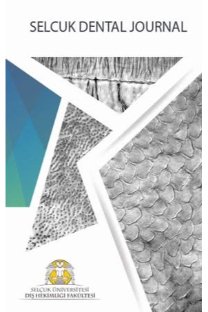Obezitenin tükürük PH'sı, tamponlama kapasitesi ve diş çürüğü insidansı'na etkisi+
Effects of obesity on salivary PH, buffering capacity and dental caries incidence
___
- 1. Palmer C. A. Dental caries and obesity in children: different problems, related causes. Nutrition and oral Health Quintessence Int. 2005;36(6): 457-61.
- 2. Akbulut GÇ, Özmen MM, Besler HT. Çağın hastalığı obezite -tanımı,saptanması, sınıflandırılması,nedenleri, kronik hastalıklarla ilişkisi ve tedavi yöntemleri- Bilim ve Teknik Dergisi 2007: (Mart) 2-15.
- 3. Saydam G, Oktay İ, Möller I: Türkiyede ağız diş sağlığı durum analizi. İstanbul 1990 In: Akyüz, S. Dünden bugüne fluor. İstanbul; 69-75.
- 4. Lamp C. Agriculture and Natural Resources Sugars and Health 2500 West Burrel Avenue, Vısalıa, Calıfornıa 93291-4584 Source: Nutrition Updates; Spring/Summer 2000.
- 5. WHO, Obesity report 2000: Obesity: preventing and managing the global epidemic. Report of a WHO consultation. World Health Organ Tech Rep Ser 2000:894:ixii, 1253.
- 6. Menteş A. R. Tükrük akış hızı pH ve tamponlama kapasitesi ile çürük indeksi aralarındaki ilişkinin bir grup genç erişkinde incelenmesi. Ankara Ün Diş Hek Fak Der 1995; 1(22): 27-33.
- 7. Dawes C. Factors influencing salivary flow rate and composition. In: Edgar WM, OMullane D, editors. Saliva and oral health. London: British Dental Association 1996: 27-41.
- 8. Yarat A, Akyuz S, Koc L, Erdem H, Emekli N. Salivary sialic acid, protein, salivary flow rate, pH, buffering capacity and caries indices in subjects with Downs syndrome. J Dent 1999;27:115-8.
- 9. Cogulu D, Sabah E, Kutukculer N, Ozkinay F. Evaluation of the relationship between caries indices and salivary secretory IgA, salivary pH, buffering capacity and flow rate in children with Downs syndrome. Archives of Oral Biology 2006;51: 23-28.
- 10. Atkinson JC, Baum BJ. Salivary enhancement: current status and future therapies. J Dent Edu 2001;105: 1096- 101.
- 11. Gao XJ, Fan Y, Kent RL Jr, Van Houte J, Margolis HC.Association of caries activity with the composition of dental plaque fluid .J Dent Res 2001;80(9):1834-9.
- 12. Hergüner Ş, Hürmüzlü F. Çürük aktivite testleri Cumhuriyet Üniversitesi Diş Hekimliği Fakültesi Derg 2005;8(2): 113-118.
- 13. Bardow A, Moe D, Nyvad B, Nauntofte B. The buffer capacity and buffer systems of human whole saliva measured without loss of CO2. Arch Oral Biol 2000;45: 1-12.
- 14. Heintze U, Birkhed D, Björn H. Secretion rate and buffer of resting and stimuled whole saliva as a function of age an sex. Swed Dentr 1983;7: 227-38.
- 15. Powers PS, Holland P, Miller C, Powers HP. Salivation patterns of obese and normal subjects. Int J Obes 1982, 6: 267-70.
- 16. Sreebny CM. Saliva in health and disease: an appraisal and update. Int Dent J 2000; 50: 140-61.
- 17. Ship JA, Pillemer SR, Baum BJ. Xerostomia and the geriatric patient. J Am Geriatr Soc 2002; 50: 535-43.
- 18. Şengün A, Duran İ, Botsalı HE, Dönmez N. Behçet Hastalığı olan kişilerde tükürük pHsı, tamponlama kapasitesi ve çürük insidansının değerlendirilmesi, Selçuk Üniversitesi Dişhekimliği Fakültesi Derg 2008;17:1-5.
- 19. Ericsson Y: Clinical investigations of the salivary buffering action. Acta Odontol Scan, 1959;17: 131-165.
- 20. Amano A, Kishima T, Kimura S, Takiguchi M, Ooshima T, Hamada S, et al. Periodontopathic bacteria in children with Downs syndrome. J Periodontol 2000;71:249-55.
- 21. Benderli Y, Erdilek D, Koray F, Telci A, Turan N. The relation between salivary IgA and caries in renal transplant patients. Oral Surg Oral Med Oral Pathol Oral Radiol Endod 2000;89:588-9.
- 22. Pannunzio E, Amancio OMS, De Souza Vitalle MS, De Souza DN, Mendes FM, Nicolau J. Analysis of the stimulated whole saliva in overwight and obese school children. Rev Assoc Med Bras 2010; 56 (1):32-6
- 23. de Oliveira CG, Collares EF, Barbieri MA, Fernandes MI. Production and concentration of saliva and salivary amylase in obese children. Arq Gastroenterol 1997;34: 105-11.
- 24. Fenoll-Palomares C, Muñoz-Montagud J. V, Sanchiz V, Herreros B, Hernández V et al. .Unstimulated salivary flow rate, pH and buffer capacity of saliva in healthy volunteers. Rev Esp Enferm Dıg 2004;96: (11) 773-783.
- 25. Inamura Y, Izumi T, Sakurai K, Katsui T, Murayama N. Dietary factors associated with obesity in patients with Schizophrenia living at home. Food and Nutrition Science 2012; 3:1387-1396.
- ISSN: 1300-5170
- Yayın Aralığı: Yılda 3 Sayı
- Başlangıç: 1991
- Yayıncı: İsmail Marakoğlu
In vitro evaluation of marginal leakage using various temporary filling materials
Ayçe ELDENİZ ÜNVERDİ, MAKBULE BİLGE AKBULUT, MEHMET BURAK GÜNEŞER
Zirkonya: Yapısı ve altyapı üretim tekniği
Toplumumuzda diş ipi kullanma alışkanlığı
İki farklı porselen laminate veneer restorasyonun kenar uyumunun in-vitro olarak değerlendirilmesi+
MERAL ARSLAN MALKOÇ, Atiye Nilgün ÖZTÜRK, Şerife Tuba BÜYÜKÖZER, Bora ÖZTÜRK
Tooth shade assessment after lingual retainer application: A prospective clinical trial
Hasan Önder GÜMÜŞ, Faruk İzzet UÇAR, Hayriye ŞENTÜRK, Tancan UYSAL
Obezitenin tükürük PH'sı, tamponlama kapasitesi ve diş çürüğü insidansı'na etkisi+
Abdulkadir ŞENGÜN, NAZMİYE DÖNMEZ, İsmet DURAN, H.Esra ÜLKER
Leyla B. AYRANCI, Hakan ARSLAN, H. Sinan TOPÇUOĞLU
Betül GÜNEŞ, Hale AYDINBELGE ARI
Hakan ARSLAN, Çağatay BARUTCİGİL, Duygu KÜRKLÜ, Hüseyin ERTAŞ
